AMD Kaveri Review: A8-7600 and A10-7850K Tested
by Ian Cutress & Rahul Garg on January 14, 2014 8:00 AM ESTCPU Performance: Continued
Xilisoft Video Converter 7 - link
The XVC test I normally do is updated to the full version of the software, and this time a different test as well. Here we take two different videos: a double UHD (3840x4320) clip of 10 minutes and a 640x266 DVD rip of a 2h20 film and convert both to iPod suitable formats. The reasoning here is simple – when frames are small enough to fit into memory, the algorithm has more chance to apply work between threads and process the video quicker. Results shown are in seconds and time taken to encode. XVC also offers acceleration via CUDA and AMD APP, so if these are available on the CPU we offer results with and without.
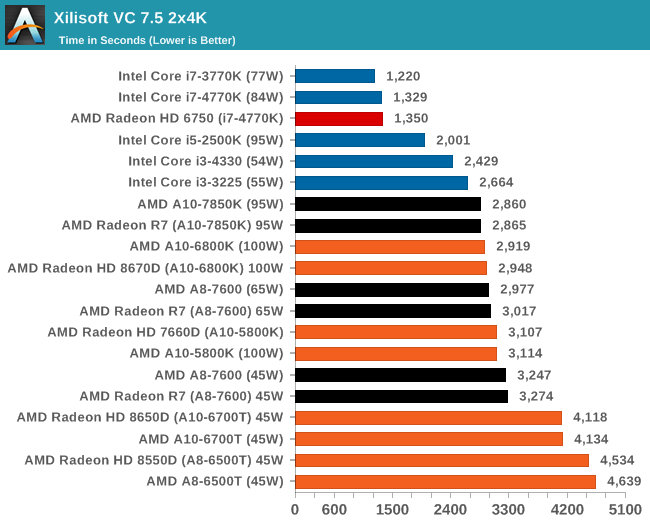
With large frame data, the IGP on Kaveri does not particularly help much.

For smaller frames however, there is an advantage to enabling the AMD APP function.
HandBrake v0.9.9 - link
For HandBrake we do the same files as XVC but convert them into the default format Handbrake offers upon loading the software. Results shown are in Frames Per Second.

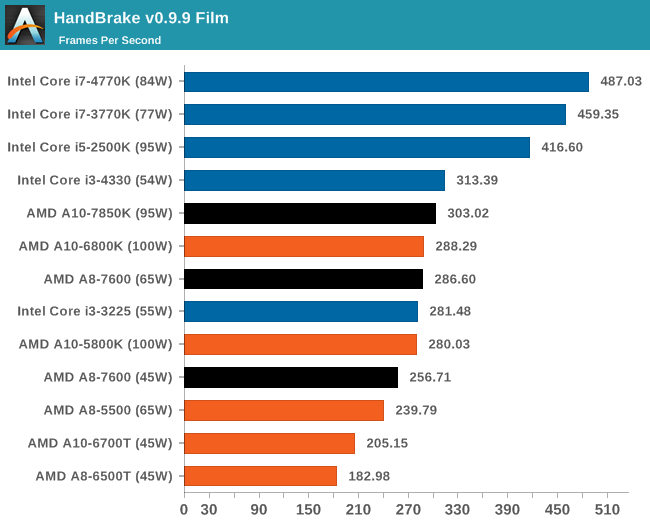
Handbrake loves cores, threads and MHz
Adobe After Effects 6
Published by Adobe, After Effects is a digital motion graphics, visual effects and compositing software package used in the post-production process of filmmaking and television production. For our benchmark we downloaded a common scene in use on the AE forums for benchmarks and placed it under our own circumstances for a repeatable benchmark. We generate 152 frames of the scene and present the time to do so based purely on CPU calculations.

7-Zip 9.2 - link
As an open source compression tool, 7-Zip is a popular tool for making sets of files easier to handle and transfer. The software offers up its own benchmark, to which we report the result.
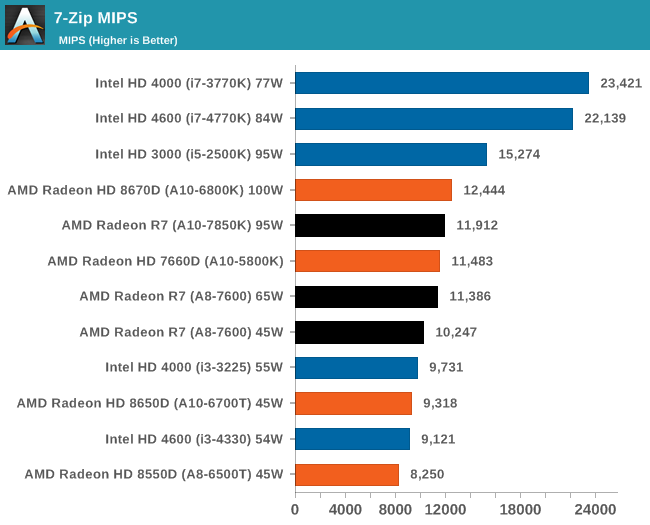
PovRay 3.7 - link
PovRay historically loves threads, MHz and IPC. The standard benchmark from PovRay is what we use to test here.
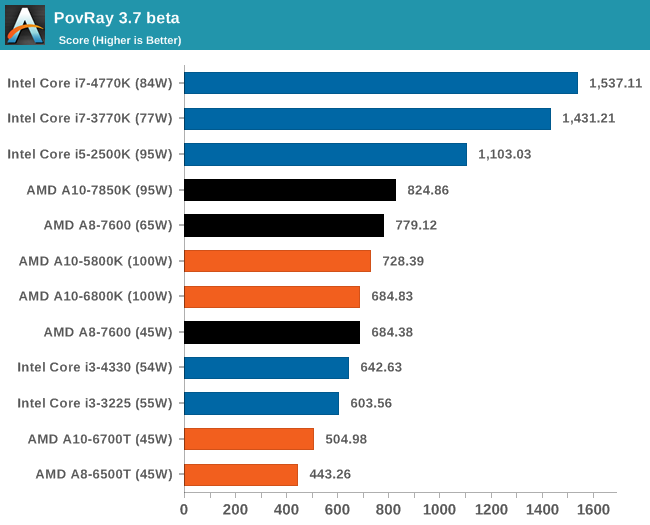
TrueCrypt 7.1a - link
TrueCrypt is an off the shelf open source encoding tool for files and folders. For our test we run the benchmark mode using a 1GB buffer and take the mean result from AES encryption.
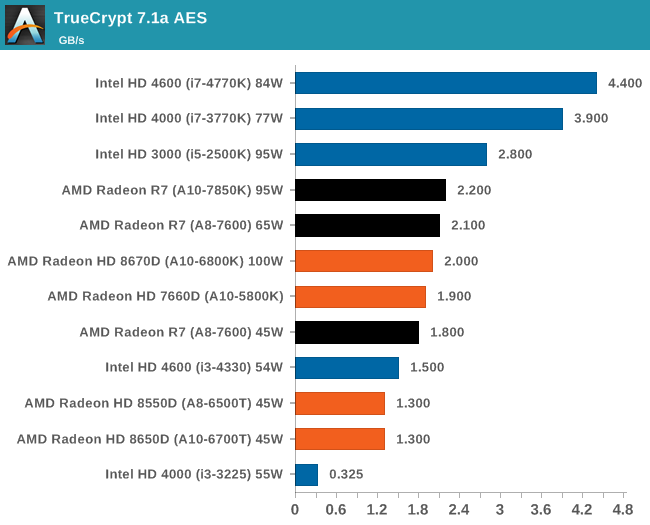










380 Comments
View All Comments
SofS - Wednesday, January 22, 2014 - link
Following your links and looking around I found:http://www.tomshardware.com/reviews/core-memory-sc...
It links to previous similar articles concerning the Phenon II and the i7 of the time (975). Seems that indeed the C2Q does not benefit much from memory improvements compared to the other two, but there is a difference. This and all of those three cases are relevant since all three models were very popular. Also, I remember choosing the on time smaller modules for my first kit whit this particular system since they were the only reasonable DDR3 modules at 1600 within reach, albeit I never managed to stabilize it at CL6. On the other hand the latter I upgraded with got CL6 from XMP since the beginning while being larger. Given that memory is very cheap compared to the whole system plus the cost of repurchasing non portable software then this (maybe also a new GPU) might just be the final push needed to wait for the next generation native DDR4 systems for many.
fokka - Tuesday, January 14, 2014 - link
i understand your sentiment, but then again, about every modern mainstream cpu should destroy a c2d and even quad in raw performance. and you even get relatively capable integrated graphics included in the package, so about everyone even moderately interested in computing performance and efficiency "should bite the bullet" if he's got a couple hundred bucks on the side.just4U - Wednesday, January 15, 2014 - link
and that's the problem.. their not. "It's good enough" Numbers are.. just that numbers. We hit a wall in 2008 (or there abouts..) and while performance kept increasing it's been in smaller increments. Over the span of several generations that really can add up but not the way it once did.It used to be you'd get on a old system and it would be like pulling teeth because the differences were very noticeable and in some cases they still are.. but for the most part? Not so much.. not for normal/casual usage. There is a ceiling .. Athlon X2s P4s? No.. you'll notice it.. Quad 8x Core2? hmmm.. How about a socket 1366 cpu or the 1156 stuff? Or the PIIs from AMD. Those people should upgrade? Certainly if their board dies and they can't replace.. but otherwise not so much.
just4U - Wednesday, January 15, 2014 - link
That should have read Quad 8x series Core2s.. anyway these days It seems like we do a lot more change out video, add in ssd, increase ram, rather then build systems from the ground up as systems can stick around longer and still be quite viable. Yes/no?tcube - Thursday, January 16, 2014 - link
Totaly agree. We're led to believe that we need to upgrade every 2 years or so... yet a great many are still using old cpu's even dual cores with new software and os without a care in the world. Because there is no noticeable improvement in cpu usage. Cpu power became irrelevant after C2Q nothing beyond that power is justifiable in normal home or office usage. Certainly certain professional users will want a cheap workstation and will buy into the highend pc market likewise extreme gamers or just for bragging rights. But thinking that for anything from browsing to medium photoshop usage or any moderate videoediting software use will REQUIRE anything past a quadcore like lowend i5's or this kaveri is plain false. You will however notice the lack of a powerful gpu when gaming or doing other gpu intensive tasks... so amd has a clear winner here.I do agree it's not suited for heavy x86 work... but honestly... most software stacks that previously relied heavily on cpu are moving to opencl to get a massive boost from the gpu... photoshop being just one of many... so yeah the powerful gpu on kaveri is a good incentive to buy, the x86 performance is better then richland which is sufficient for me(as i currently do use a richland cpu) so...
Syllabub - Friday, January 17, 2014 - link
I am not going to try and pick a winner but I follow your line of reasoning. I have a system with a e6750 C2D and Nvidia 9600 that still gets the job done just fine. It might be described as a single purpose type of system meaning I ask it to run one or possibly two programs at the same time. What I think is pretty wild is that when I put it together originally I probably sank something close to $250 into the CPU and GPU purchase while today I potentially get similar performance for under $130 or so. The hard part is buying today in a manner that preserves a level of performance equivalent to the old system; always feel the tug to bump up the performance ladder even if I don't really need it.Flunk - Thursday, January 16, 2014 - link
That doesn't really make sense unless you also include equivalently-priced current Intel processors. People may be moving on from Core 2s but they have the opportunity to buy anything on the market right now, not just AMD chips.PPB - Tuesday, January 14, 2014 - link
Adding a $350 CPU plus $50 GPU to a iGP gaming comparison = Anandtech keeping it classy.MrSpadge - Tuesday, January 14, 2014 - link
You do realize they're not recommending this in any way, just showing the full potential of a low-end discrete GPU which wouldn't be bottlenecked by any modern 3+ core CPU?Homeles - Tuesday, January 14, 2014 - link
PPB being an ignorant critic, as usual."For reference we also benchmarked the only mid-range GPU to hand - a HD 6750 while connected to the i7-4770K."